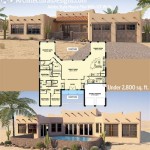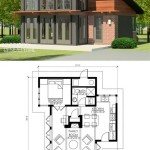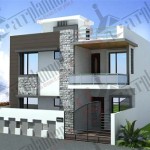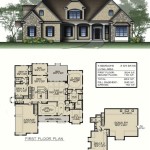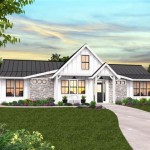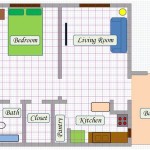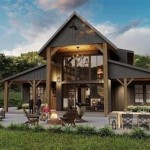2-Story Garage House Plans: Expanding Living Spaces Vertically
Two-story garage house plans, often referred to as garage apartments or carriage houses, represent a strategic approach to maximizing space utilization on residential properties. These designs typically integrate a ground-level garage for vehicle storage and/or workshop purposes with a fully functional living space located on the second story. This arrangement offers several advantages, including increased living area, potential rental income opportunities, and enhanced property value. The architectural styles and floor plan configurations are diverse to accommodate a range of needs and preferences.
The appeal of a 2-story garage house plan lies in its practicality and adaptability. Homeowners can use the additional living space as an in-law suite, a guest house, a home office, or even a short-term rental unit. This versatility makes it a valuable investment, particularly in areas with high property values or limited land availability. The design also allows for a degree of separation between the main residence and the auxiliary living space, providing both privacy and convenience.
Choosing the right 2-story garage house plan involves careful consideration of several factors, including local zoning regulations, building codes, budget constraints, and personal preferences. A thorough understanding of these elements is crucial for a successful and compliant project. Furthermore, professional architectural advice is highly recommended to ensure the structural integrity, functional efficiency, and aesthetic appeal of the final product.
Key Considerations Before Selecting a Plan
Prior to committing to a specific 2-story garage house plan, several crucial aspects demand thorough evaluation. These considerations encompass legal compliance, spatial requirements, and intended functionality. Addressing these pre-planning elements significantly minimizes potential complications and ensures a smooth construction process.
Zoning and Building Codes: Local zoning ordinances dictate permissible land usage, building heights, setbacks, and other relevant regulations. These codes vary significantly between municipalities. Before embarking on any construction, it is imperative to consult with the local zoning department to ascertain the specific requirements for accessory dwelling units (ADUs), which often include 2-story garage apartments. Building codes, on the other hand, establish minimum standards for structural safety, fire resistance, and energy efficiency. Compliance with these codes is non-negotiable and requires strict adherence to approved building practices and materials. Failure to comply with either zoning or building codes can result in costly delays, fines, or even demolition orders.
Space Requirements and Site Conditions: The available space on the property plays a pivotal role in determining the size and layout of the garage house. Factors such as lot size, setbacks from property lines, and existing structures must be carefully considered. Furthermore, the site conditions, including soil type, drainage, and slope, can impact foundation design and construction costs. A geotechnical survey may be necessary to assess soil stability and identify any potential hazards. Adequate access for construction equipment and material delivery must also be factored into the planning process. The placement of utilities, such as water, sewer, and electricity, needs to be carefully planned to ensure efficient and cost-effective connections to the main residence or the municipal grid.
Intended Use and Functionality: The intended use of the 2-story garage house will heavily influence the design and features of the living space. For example, a guest house will require different amenities than a home office or a rental unit. Consider the number of occupants, their lifestyle, and their specific needs. Thoughtful planning of the floor plan, including the layout of bedrooms, bathrooms, kitchen, and living areas, is essential for creating a comfortable and functional living environment. Furthermore, consider accessibility requirements, such as ramps or elevators, if the space is intended for individuals with mobility limitations. The selection of appliances, fixtures, and finishes should align with the intended use and the overall aesthetic of the property.
Exploring Different Plan Styles and Layouts
The market offers a diverse range of 2-story garage house plans, each with its unique architectural style and layout configuration. The choice of style and layout depends on individual preferences, budget considerations, and the overall design aesthetic of the main residence. Understanding the different options available is crucial for making an informed decision.
Architectural Styles: Several architectural styles are commonly employed in 2-story garage house designs. These include: Traditional, often featuring pitched roofs, dormers, and classic details such as decorative trim and shutters; Contemporary, characterized by clean lines, flat roofs, and large windows; Craftsman, known for its handcrafted details, exposed rafter tails, and natural materials; Farmhouse, distinguished by its simple lines, gabled roofs, and rustic charm; and Modern, which emphasizes functionality, minimalist design, and sustainable materials. The selection of a specific architectural style should complement the existing architecture of the main residence to create a cohesive and harmonious aesthetic.
Floor Plan Configurations: The floor plan configuration determines the layout and flow of the living space. Common configurations include: Open-concept layouts, which create a spacious and airy feel by combining the living room, dining area, and kitchen into a single open space; Split-level layouts, which separate the living areas from the sleeping areas; and Multi-room layouts, which provide distinct rooms for each function. The choice of configuration depends on the size of the living space, the number of occupants, and their individual preferences. Consider the placement of windows and doors to maximize natural light and ventilation. The layout should also prioritize privacy and minimize noise transmission between the garage and the living space.
Customization Options: Many 2-story garage house plans offer customization options to tailor the design to specific needs and preferences. These options may include: Modifying the floor plan to add or remove rooms; Altering the exterior design to match the existing architecture; Choosing different finishes and materials; and Adding or upgrading appliances and fixtures. Customization allows homeowners to create a unique and personalized living space that meets their individual needs and reflects their personal style. However, it is important to note that customization can add to the overall cost of the project and may require additional planning and design work.
Essential Features and Design Considerations
Several essential features and design considerations contribute to the functionality, comfort, and value of a 2-story garage house. These elements encompass structural integrity, energy efficiency, accessibility, and aesthetic appeal. A holistic approach to design ensures a well-rounded and desirable living space.
Structural Integrity and Safety: The structural integrity of the garage house is paramount, ensuring the safety and longevity of the building. A solid foundation is crucial for supporting the weight of the structure and resisting soil movement. Proper framing techniques and the use of high-quality building materials are essential for creating a durable and stable structure. Fire-resistant materials should be used throughout the building to minimize the risk of fire damage. Smoke detectors and carbon monoxide detectors should be installed in accordance with local building codes. A well-designed ventilation system is also important for preventing moisture buildup and maintaining good air quality.
Energy Efficiency and Sustainability: Energy-efficient design features can significantly reduce utility costs and minimize environmental impact. Proper insulation in the walls, roof, and floors helps to maintain a comfortable temperature year-round. Energy-efficient windows and doors reduce heat loss and gain. Energy-efficient appliances and lighting fixtures consume less energy. Consider incorporating renewable energy sources, such as solar panels, to further reduce energy consumption. Water-efficient fixtures and landscaping practices can conserve water. The use of sustainable building materials, such as recycled lumber and bamboo flooring, can minimize the environmental footprint of the project.
Accessibility and Universal Design: Incorporating accessibility features can make the garage house more usable for individuals with disabilities or mobility limitations. Ramps or elevators provide access to the second floor. Wider doorways and hallways accommodate wheelchairs and walkers. Grab bars in bathrooms and kitchens provide support. Lever-style door handles are easier to operate than knob-style handles. Consider incorporating universal design principles throughout the building to create a space that is usable by people of all ages and abilities. This includes features such as adjustable countertops, roll-under sinks, and easy-to-reach storage.
Aesthetic Appeal and Curb Appeal: The aesthetic appeal of the garage house can significantly enhance the overall property value. Choose an architectural style that complements the existing architecture of the main residence. Select exterior finishes and materials that are durable and visually appealing. Landscaping can enhance the curb appeal of the garage house. Consider adding features such as a front porch, a balcony, or a deck to create an inviting outdoor space. Pay attention to details such as lighting, signage, and landscaping to create a welcoming atmosphere.
By carefully considering these factors and working with experienced professionals, homeowners can successfully implement a 2-story garage house plan that meets their needs, enhances their property, and provides a valuable and functional living space.

Small 2 Story House Floor Plan With Car Garage

Pin On Dream Home

House Plan With 2 Car Garage

Contemporary 3 Bedroom House Plan With 2 Car Garage 80917pm Architectural Designs Plans

House Plan 3 Bedrooms 2 5 Bathrooms Garage 3883 V1 Drummond Plans

Pin On Homes

3 Bedroom Floor Plan With 2 Car Garage Max Fulbright Designs

Two Story Four Bedroom House Plan With Garage

House Plan With 2 Car Garage

Two Story 4 Bedroom Home Plan With 3 Car Garage House Plans Floor

